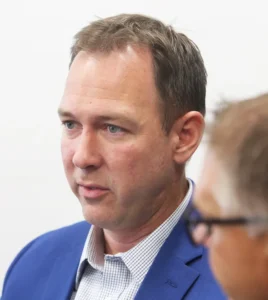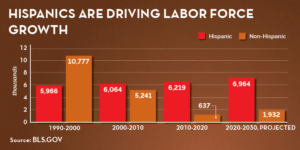
Business Leaders Seek to Capitalize on Hispanic Workforce Growth in U.S.
While some U.S. cities are overflowing with migrants, Topeka officials are trying to recruit them. They offer $15,000 to legal migrants to relocate to the capital of Kansas to fill job vacancies and add to the city’s existing diversity. The Greater Topeka Partnership spearheads the program that reimburses local businesses for hiring migrants.
Latino immigrants are the main target. Most Americans couldn’t find Topeka on a map and may wonder why a city in a red state like Kansas would prioritize Latino recruitment. One reason is the city’s history. Kansas was admitted to the Union in 1856 as a free state. Topeka was chartered as a Free-State city the following year. Its founders were a mix of anti-slavery Northeasterners and freed slaves. Latinos were imported to build the railroad.
 The culturally mixed background of Topeka has made the community open to recruiting migrants from Mexico, Central America and South America. The Kansas Health Institute reports 34 percent of Topeka public school students identify as Hispanic. There is a push to increase bilingualism for both native Spanish speakers and native English speakers.
The culturally mixed background of Topeka has made the community open to recruiting migrants from Mexico, Central America and South America. The Kansas Health Institute reports 34 percent of Topeka public school students identify as Hispanic. There is a push to increase bilingualism for both native Spanish speakers and native English speakers.
Tapping Growing Workforce
Another reason is practicality. According to Bob Ross of the Greater Topeka Partnership, a majority of new workers in the city are Latinos, matching a national trend. Bureau of Labor Statistics reveal Hispanic participation in the U.S. labor market grew from 10.7 million in 1990 to 29 million in 2020. It’s projected to grow to almost 36 million by 2030, outpacing new non-Hispanic workers in that period by more than three to one, a fact Topeka business leaders recognize.
Ross said the partnership’s Latino outreach effort is supported by the Greater Topeka Chamber of Commerce, Downtown Topeka and GO Topeka. Local government is also involved, he says, with the explicit goal “to foster a diverse and bilingual community”. Local businesses also recognize Latinos are the most likely recruits willing to move to Kansas for jobs and cultural acceptance.
The recruitment is more than a fad or short-term endeavor. Ross points to the 90th anniversary of Fiesta Topeka, which occurs on the grounds of a Mexican-American church in the neighborhood where earlier Latino migrants settled. The well-attended festival now runs five days in July and includes food, entertainment, a golf tournament and a 5K race.
A new event sponsored by the nonprofit For the Culture launched this summer. It celebrates Topeka’s Black and Native American populations. The name of the city came from Native American language. Charles Curtis, the only Native American to serve as vice president during the Herbert Hoover administration, was born in Topeka.
 The Midwest has grown slower than the rest of the country, Ross says. “This reality, combined with the Midwestern habit of hospitality, has pushed Topeka and other cities in the region to develop programs to integrate migrant and refugee populations in ways that can benefit all,” he explains. “We are probably ahead of the curve on these conversations.”
The Midwest has grown slower than the rest of the country, Ross says. “This reality, combined with the Midwestern habit of hospitality, has pushed Topeka and other cities in the region to develop programs to integrate migrant and refugee populations in ways that can benefit all,” he explains. “We are probably ahead of the curve on these conversations.”
“We’re being intentional in talking to Hispanic stakeholders about how we can market more authentically to that demographic,” Ross adds. “We see the growing Hispanic population as a very powerful talent pool that we can draw on over the next 10 to 20 years.”
“We see the growing Hispanic population as a very powerful talent pool.”
 Intentional Reach Out to Refugees
Intentional Reach Out to Refugees
Topeka’s outreach extends to other refugees. Yana Ross, who emigrated from Ukraine 17 years ago, leads the Partnership’s effort to recruit refugees. The nonprofit Top City Promise has a network of 700 volunteers who find and furnish apartments and deliver food to resettled refugees. So far, the group has placed 130 refugees, half of them children, in 30 ready-to-occupy apartments as well as providing cash and in-kind services totaling $500,000. Topeka’s population is around 160,000 people.
“We’re trying to use our experiences to streamline things and have a map of how to integrate these families into the Topeka community and make them independent,” Yana Ross says. That work includes developing a newcomer’s academy to help refugees learn about city government and visit key locations.
 Publicity of Topeka’s spunky outreach effort got under the skin of New York City Mayor Eric Adams who belittled the city and its outreach in the face of his city’s dilemma coping with a large influx of migrants. True to form, Bob Ross turned the sleight into a PR opportunity for Topeka’s recruitment program.
Publicity of Topeka’s spunky outreach effort got under the skin of New York City Mayor Eric Adams who belittled the city and its outreach in the face of his city’s dilemma coping with a large influx of migrants. True to form, Bob Ross turned the sleight into a PR opportunity for Topeka’s recruitment program.
Schools Involved, Too
Topeka Public Schools is also involved. The district stood up a newcomer program for migrant children. There is a dual language elementary school and English language studies are offered at all grade levels. The District encourages all its administrators to learn Spanish. “We are becoming a bilingual school system,” says Pilar Mejia, director of cultural innovation and a native Colombian who is fluent in three languages.
School officials say the emphasis on bilingual education has helped Topeka fill teacher shortages by attracting teachers from Puerto Rico, Spain and the Philippines.
“We gain the opportunity to teach young people how to be global leaders and collaborators, how to be inclusive and be better individuals,” Superintendent Tiffany Anderson says. “We gain the opportunity to be empowered with economic prosperity, ensuring we have ways to uplift individuals and allow cultures to come together and strengthen the fabric of our community.”




